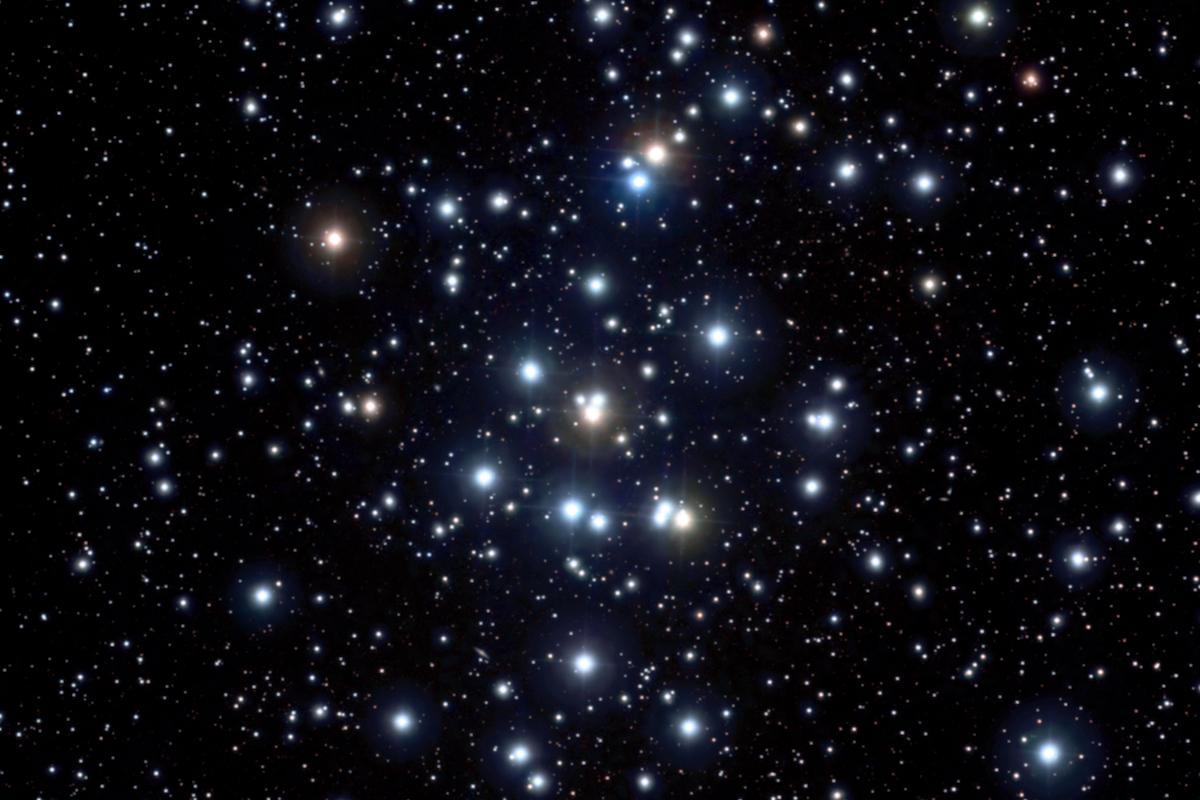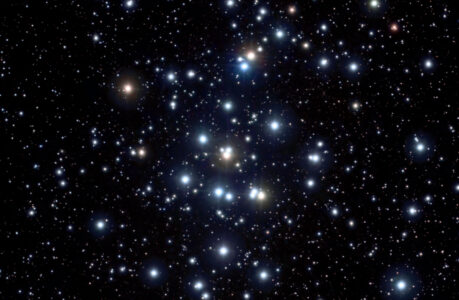The Beehive Cluster, also known as M44 or Praesepe, is a beautiful open cluster of stars located in the constellation Cancer. It is one of the nearest and most easily visible star clusters, making it a popular target for both amateur and professional astronomers. The Beehive Cluster is estimated to be about 600 million years old, making it a relatively young cluster in astronomical terms.
The cluster is located approximately 577 light-years away from Earth and contains over 1,000 stars. Its name comes from its appearance as a swarm of bees when viewed through a small telescope. The Beehive Cluster is also known by its Latin name, Praesepe, which means “manger” or “crib.”
The Beehive Cluster is a particularly interesting target for observation because of its size and the variety of stars it contains. It spans over 30 light-years across, making it one of the larger open clusters visible from Earth. The stars in the cluster range in size from red giants to yellow dwarfs and blue-white giants, making it a diverse and dynamic group.
To observe the Beehive Cluster, it is best to use a telescope or binoculars. Its location in the constellation Cancer makes it visible from both hemispheres of the Earth, although it is most easily observed in the northern hemisphere during the winter months.
The Beehive Cluster has a rich history of observation, dating back to ancient times. The Greek astronomer Hipparchus first recorded the cluster in the second century BCE, and it has been studied by many astronomers since then. In the 17th century, Galileo Galilei observed the Beehive Cluster and described it as a “cloudy spot” in the sky.
In addition to its beauty and scientific significance, the Beehive Cluster also has cultural significance. It has been referenced in many cultures throughout history, including Greek mythology, where it was associated with the goddess Aphrodite. It is also referenced in Chinese astronomy, where it is known as “Jishi,” meaning “the Exhalation of Piled-up Corpses.”
Key features of the Beehive Cluster (M44)
The Beehive Cluster, also known as M44 or Praesepe, is an open cluster of stars located in the constellation Cancer. Here are some key features of this stunning celestial object:
- Size: The Beehive Cluster is one of the larger open clusters visible from Earth, spanning over 30 light-years across.
- Age: The cluster is estimated to be around 600 million years old, making it relatively young in astronomical terms.
- Location: The Beehive Cluster is located approximately 577 light-years away from Earth and is visible from both hemispheres of the Earth, although it is most easily observed in the northern hemisphere during the winter months.
- Stars: The cluster contains over 1,000 stars, ranging in size from red giants to yellow dwarfs and blue-white giants, making it a diverse and dynamic group.
- Appearance: When viewed through a small telescope, the Beehive Cluster appears as a swarm of bees, hence its name.
- Cultural Significance: The Beehive Cluster has been referenced in many cultures throughout history, including Greek mythology and Chinese astronomy.
Finding the Beehive Cluster (M44)
Finding the Beehive Cluster, also known as M44 or Praesepe, can be a fun and rewarding experience for stargazers. Here are some tips on how to locate this stunning celestial object in the night sky:
- Know the constellation: The Beehive Cluster is located in the constellation Cancer. Familiarize yourself with the pattern of stars in this constellation, as it will help you locate the cluster.
- Look for Cancer: Find the constellation Cancer in the night sky. It can be identified by its distinctive shape, which resembles a crab.
- Locate the Beehive Cluster: The Beehive Cluster can be found between the stars Eta and Delta Cancri in the center of the constellation. It may be visible as a small, hazy patch of light to the naked eye.
- Use binoculars or a telescope: To get a better view of the Beehive Cluster, use binoculars or a telescope. It should be visible as a group of stars that appear to be swarming together.
- Check the time of year: The Beehive Cluster is most easily observed in the northern hemisphere during the winter months, when it is high in the sky and the nights are longer.
Remember to give your eyes time to adjust to the darkness, and try to observe from a location with minimal light pollution. With a little patience and perseverance, you should be able to locate the Beehive Cluster and marvel at its beauty in the night sky.
What is an open cluster?
An open cluster is a group of stars that are loosely bound together by gravity and typically have a common origin. Open clusters are relatively young, typically less than a few hundred million years old, and are found in the disk of a galaxy. They are often located in the spiral arms of a galaxy, where the gas and dust concentrations are higher, allowing for the formation of new stars. Open clusters are different from globular clusters, which are much older, more densely packed, and have a more spherical shape. Open clusters can contain anywhere from a few dozen to several thousand stars and can be easily observed with telescopes and binoculars. They are valuable to astronomers because they provide insights into the formation and evolution of stars and galaxies.

